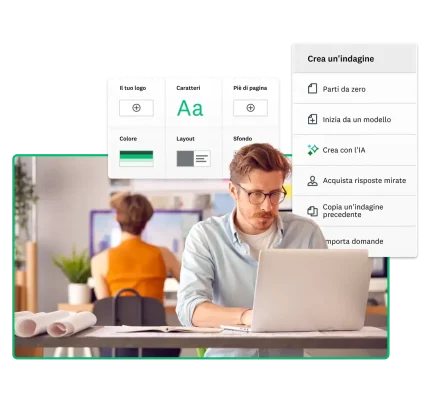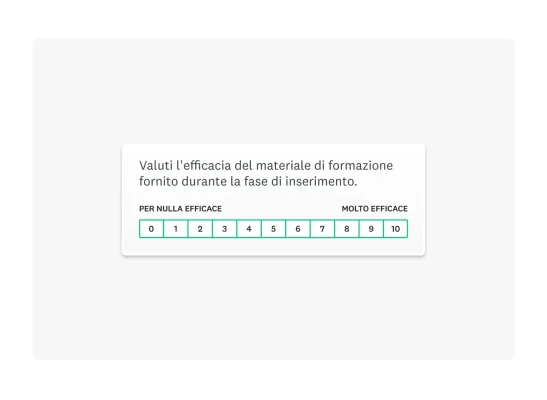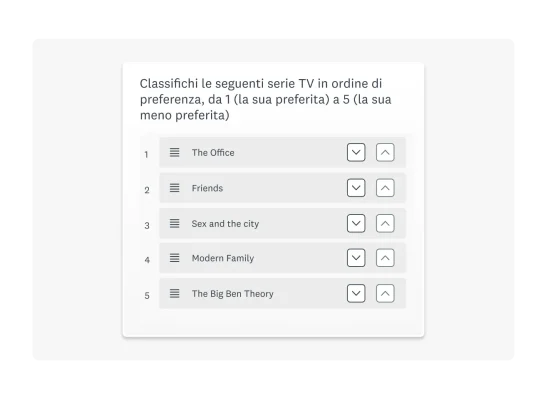Come creare quiz gratis
Scopri come funziona lo strumento interattivo per la creazione di quiz di SurveyMonkey oppure utilizza uno dei nostri modelli per creare rapidamente un quiz da inviare gratis.

- Vuoi progettare un quiz online? Scegli le domande giuste, imposta le regole per il calcolo del punteggio e condividi il quiz in modo strategico.
- I quiz online si dividono in varie categorie: dalle valutazioni della formazione, ai test di abilità e conoscenze, alle verifiche accademiche, fino ai quiz di curiosità o ai giochi. Ognuna è finalizzata a obiettivi specifici come l'apprendimento, la convalida delle competenze o l'intrattenimento.
- Le domande dei quiz devono essere chiare, concise, in linea con gli obiettivi del questionario e offrire opzioni di risposta plausibili per valutare efficacemente il livello di conoscenza o di comprensione.
Se stai cercando un modo facile e veloce per realizzare quiz online gratuitamente, sei nel posto giusto. SurveyMonkey ha messo a punto uno strumento per la creazione di quiz online gratuito che puoi utilizzare per creare, personalizzare e distribuire quiz e per raccogliere le relative risposte.
Ecco la nostra guida rapida per creare quiz con SurveyMonkey e ottenere il massimo risultato. Scoprirai come si crea un quiz, cosa lo rende efficace, come puoi inviarlo ed esempi di domande per quiz diversi.
Come creare un quiz con SurveyMonkey
Realizzare quiz online è semplicissimo con SurveyMonkey. Il nostro strumento per la creazione di quiz online ti aiuta a crearli, distribuirli e raccogliere i risultati.
Ecco come funziona:
- Crea un account SurveyMonkey gratuito oppure accedi e scegli uno dei nostri modelli di quiz online. Se hai già in mente un tipo di quiz in particolare, puoi anche selezionare l'opzione “Parti da zero”.
- Scegli Crea per aggiungere domande al tuo questionario.
- Abilita l'opzione “Assegna un punteggio a questa domanda (abilita modalità quiz)” per ciascuna domanda.
- Quindi, assegna dei punti alle opzioni di risposta utilizzando il segno più o meno.
- Distribuisci il quiz via email, social media, link al web o chat per dispositivi mobili.
Trasformazione di un'indagine in un quiz
Se hai maggiore familiarità con la creazione di indagini, puoi utilizzare la stessa procedura anche per creare un quiz. Per prima cosa, registrati per ottenere un account SurveyMonkey gratuito o accedi a un account esistente. Da lì, scegli Crea indagine, quindi Parti da zero. A questo punto, puoi aggiungere le tue domande con il pulsante Crea, inserendo qualunque testo desideri includere.
Se hai dei dubbi su cosa chiedere, puoi utilizzare la nostra Banca delle domande dove trovi tantissimi quesiti già pronti.
Uso di un modello esistente SurveyMonkey per quiz
Se hai dei dubbi su cosa includere nel tuo quiz, puoi sempre partire da uno dei modelli per quiz online di SurveyMonkey. Dal menu scegli Crea indagine, quindi Inizia da un modello. Apparirà un menu a tendina in cui puoi selezionare Quiz e sfogliare l'intera raccolta.
Una volta trovato un modello di quiz che fa al caso tuo, seleziona Usa questo modello.
Quali tipi di quiz esistono?
È possibile creare quiz su praticamente qualsiasi cosa. In alcuni casi si utilizzano per testare i dipendenti, come nel caso del quiz di formazione aziendale su temi legali. Altri quiz hanno finalità puramente ludiche e possono essere usati per intrattenere gli amici, come quello sulla visione di film e TV, utile per scoprire cosa le persone amano guardare in televisione.
Esaminiamo alcune tipologie di quiz che potresti decidere di utilizzare.
Quiz per la valutazione della formazione

Al momento dell'inserimento, i neoassunti devono spesso seguire diversi corsi di formazione online per essere aggiornati sulle procedure aziendali e su altri aspetti correlati alla loro posizione. Ma quante aziende si prendono un momento per valutare come vivono i nuovi assunti questo processo e se si sentono pronti ad affrontare il loro nuovo lavoro? Un questionario sul processo di inserimento ti permette di farlo. I risultati possono aiutarti a migliorare l'esperienza di onboarding nel suo complesso.
Al termine di ogni modulo formativo, puoi utilizzare dei quiz di valutazione dell'apprendimento per vedere se i dipendenti riescono a ricordare i punti chiave della formazione. Questo aiuta a ottimizzare il training iniziale dei dipendenti, in quanto permette di conoscere esattamente il livello di preparazione di ciascuno al termine di ogni modulo didattico. In questo modo, potrai aiutare chi ha maggiormente bisogno fornendo ulteriore supporto.
Puoi inoltre utilizzare le indagini per offrire ai dipendenti l'opportunità di fornire un feedback sulle proprie esperienze di formazione. Il modello di questionario per la valutazione dei corsi di formazione include domande come “Con quale probabilità consiglierebbe questa sessione ad amici o colleghi?” Nel corso del tempo, la richiesta di feedback e l'applicazione dei risultati contribuirà a migliorare i programmi di formazione offerti ai dipendenti.
Grazie a SurveyMonkey, ORA Systems è stata in grado di trasferire 82 diversi corsi di formazione in un unico sistema accessibile a tutti i dipendenti. Le piattaforme di dati centralizzate di SurveyMonkey hanno permesso all'azienda di rinnovare il proprio programma di formazione e ottenere i dati di analisi necessari per comprendere meglio le esigenze dei propri dipendenti.
Verifica di capacità e competenze
I quiz vengono molto spesso impiegati anche come strumento di verifica. Le aziende possono ricorrere a questionari per selezionare i candidati per una posizione o per valutare la conoscenza dei dipendenti di un determinato argomento attinente alle loro mansioni.
Con il modello per la valutazione dei candidati le organizzazioni possono consolidare i profili degli aspiranti dipendenti e vedere quale si adatta meglio alla posizione. Domande come “Come valuta le sue capacità di comunicazione su una scala da 1 a 5?” possono aiutare a selezionare i candidati da portare alla fase di colloquio.
Grazie alla rapidità di compilazione, i quiz si rivelano preziosi e facilmente accessibili sia per il reclutamento di candidati che per la valutazione dei dipendenti in servizio.
Test educativi o accademici online
I quiz didattici o accademici sono un tipo di questionario ampiamente conosciuto e utilizzato. Professori e insegnanti li impiegano per verificare se gli studenti hanno compreso o meno il materiale o se hanno completato le letture richieste per una lezione.
Se si considera la grande diffusione della formazione via Internet che è andata affermandosi in questi ultimi anni, la facilità di distribuzione dei quiz online è un aspetto di estrema importanza. Gli insegnanti hanno anche la possibilità di abilitare una funzione che mostra ai rispondenti i punteggi ottenuti, permettendo agli studenti di vedere cosa hanno sbagliato e a quali domande hanno risposto correttamente.
SurveyMonkey offre una serie di questionari e quiz didattici che le istituzioni accademiche possono utilizzare per acquisire informazioni utili a garantire risultati di successo basati sui dati.
Solo per divertimento: giochi a quiz

I quiz vengono utilizzati anche per puro divertimento. Se si vuole mettere alla prova gli amici, la famiglia o i colleghi, ci sono numerosi giochi a quiz che si possono utilizzare. Puoi fare domande sulla cultura pop, sullo sport e sull'attualità, oppure organizzare una serata di giochi a quiz.
I quiz ludici sono più di un semplice svago, in quanto possono diventare un potente strumento di team building. Incoraggiano la partecipazione, favoriscono la creazione di legami e creano relazioni tra gruppi di persone. Analizzando i risultati, è possibile capire quale team ha ottenuto i punteggi migliori, favorendo un senso di realizzazione collettiva e di spirito di squadra.
Come formulare buone domande per i quiz
Un quiz coinvolgente si ottiene con quesiti efficaci. Ecco alcune linee guida per redigere ottime domande per quiz.
- Prediligi la semplicità: nessuno ha voglia di leggere domande prolisse. Scrivi in modo conciso e chiaro. Domande brevi contribuiscono inoltre a ridurre le ambiguità, con conseguenti percentuali di risposta più elevate.
- Utilizza una selezione diversificata di risposte: nelle domande su preferenze, dovresti includere opzioni di risposta per tutti. Offrendo un'ampia scelta di possibili soluzioni, permetterai ai partecipanti di trovare la risposta che più desiderano, anziché accontentarsi di una che si avvicina soltanto.
- Evita domanda tendenziose e capziose: potrebbero indurre i partecipanti a rispondere in un determinato modo. Questo tipo di approccio può rovinare l'autenticità del questionario e falsarne i risultati.
- Includi un contatore delle domande: le persone potrebbero stancarsi di rispondere al quiz se non sanno quanto sono vicini al completamento. Oltre alle domande, includi quindi un contatore per mostrare lo stato di avanzamento del quiz nel suo complesso.
Se cerchi una guida più completa alla formulazione delle domande dei quiz, guarda il nostro webinar sulla creazione delle domande d'indagine per saperne di più.
Quiz online: suggerimenti e linee guida
La distribuzione online dei quiz ne favorisce l'accessibilità e permette di ottenere un maggior numero di risposte oltre a risultati più accurati.
Ecco alcune linee guida per la realizzazione di quiz online, con consigli per aumentare le percentuali di risposta e migliorare la qualità dei dati.
Usa le domande di screening per risultati accurati
Le domande di screening sono quesiti preliminari che aiutano a determinare se un rispondente è adatto al quiz o meno. Se ti interessa consultare un determinato pubblico, le domande di screening assicurano che solo le persone “giuste” rispondano al quiz.
Esistono due principali tipologie di domande di screening che puoi utilizzare: quelle comportamentali e quelle specifiche del settore. Le prime riguardano il comportamento delle persone, ad esempio si può chiedere “Quante ore alla settimana dedichi alla lettura di libri?” prima di iniziare un quiz sulle abitudini di lettura. Se qualcuno risponde zero, non sarà considerato idoneo e non potrà partecipare al quiz.
Le domande di screening specifiche del settore chiedono ai rispondenti in quale ruolo o settore operano. Ad esempio, se alla tua organizzazione interessa condurre un questionario sulle competenze del servizio di assistenza clienti, non avrai bisogno che i dipendenti che non hanno alcun contatto con la clientela vi partecipino. Una semplice domanda di screening aiuterà a escludere le persone a cui il questionario non è destinato.
L'utilizzo di strumenti di screening assicura la massima accuratezza dei dati, senza che nessuno venga inutilmente coinvolto in quiz di scarsa rilevanza.
Scegli la giusta tipologia di domande per il quiz
I migliori quiz si basano su domande appropriate. Per ogni quiz possono essere più adatte certe tipologie di domande. Ad esempio, un quiz accademico si presta a domande a scelta multipla. Mentre, se devi valutare le competenze dei dipendenti, consentire risposte a scala Likert potrebbe essere l'opzione migliore.
Un metodo utile per determinare il tipo di domanda più adatto consiste nel considerare il risultato che si vuole ottenere. Alcuni quiz mostrano le risposte corrette ai partecipanti, mentre altri generano solo dati utilizzabili dall'azienda.
Altre risorse: Tipi di domande per questionari: esempi e suggerimenti.
Mostra subito il punteggio ai rispondenti
La maggior parte dei rispondenti non vuole aspettare per avere le risposte ai quiz. Se hanno dedicato del tempo a rispondere a un questionario, vorranno vedere i loro risultati il prima possibile. Con i quiz di SurveyMonkey, i rispondenti sono in grado di visualizzare automaticamente se hanno risposto in modo corretto o errato al termine di ogni domanda. Puoi abilitare o disabilitare questa opzione, in base al tipo di quiz che desideri lanciare.
In alcuni tipi di quiz, è fondamentale mostrare ai partecipanti i loro punteggi. Gli studenti, ad esempio, vorranno conoscere al più presto il voto complessivo ottenuto.
Domande frequenti
- Come si crea un nuovo quiz?
- Cosa determina il successo di un quiz?
- Quali sono gli strumenti migliori per creare quiz online gratis?
Crea rapidamente quiz online con SurveyMonkey
I quiz online sono un efficace strumento per testare abilità, competenze o semplicemente per divertirsi un po'. Sia che si tratti di esaminare candidati a una posizione lavorativa, o che si cerchi di stimolare il coinvolgimento di studenti o dipendenti, i quiz si rivelano particolarmente utili.
Le migliori soluzioni gratuite per la creazione di quiz online includono l'assegnazione automatica dei punteggi, modelli da cui partire, modalità di distribuzione semplificate e funzioni efficaci per la raccolta e l'analisi dei dati. SurveyMonkey ti permette di fare tutto questo e molto altro, consentendoti di creare e condividere quiz in pochi minuti.
Vuoi cominciare?
Discover more resources

Soluzioni per ogni ruolo
SurveyMonkey può aiutarti a lavorare meglio. Scopri come migliorare il tuo impatto con strategie, prodotti ed esperienze vincenti.

Modelli di indagine
Oltre 400 modelli di questionari personalizzabili redatti da esperti per creare e inviare indagini coinvolgenti in modo rapido.

Moduli per colloqui di fine rapporto per capire cosa migliorare
Poni le domande giuste nei colloqui di fine rapporto per ridurre l'abbandono dei dipendenti. Inizia oggi stesso con i nostri strumenti e modelli.

Ricevi le autorizzazioni necessarie con i moduli di consenso online
Crea moduli di consenso online: raccogli firme elettroniche, garantisci la conformità e semplifica le procedure con il nostro generatore di moduli.